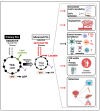Lactate as Key Metabolite in Prostate Cancer Progression: What Are the Clinical Implications?
- PMID: 37444583
- PMCID: PMC10340474
- DOI: 10.3390/cancers15133473
Lactate as Key Metabolite in Prostate Cancer Progression: What Are the Clinical Implications?
Abstract
Advanced prostate cancer represents the fifth leading cause of cancer death in men worldwide. Although androgen-receptor signaling is the major driver of the disease, evidence is accumulating that disease progression is supported by substantial metabolic changes. Alterations in de novo lipogenesis and fatty acid catabolism are consistently reported during prostate cancer development and progression in association with androgen-receptor signaling. Therefore, the term "lipogenic phenotype" is frequently used to describe the complex metabolic rewiring that occurs in prostate cancer. However, a new scenario has emerged in which lactate may play a major role. Alterations in oncogenes/tumor suppressors, androgen signaling, hypoxic conditions, and cells in the tumor microenvironment can promote aerobic glycolysis in prostate cancer cells and the release of lactate in the tumor microenvironment, favoring immune evasion and metastasis. As prostate cancer is composed of metabolically heterogenous cells, glycolytic prostate cancer cells or cancer-associated fibroblasts can also secrete lactate and create "symbiotic" interactions with oxidative prostate cancer cells via lactate shuttling to sustain disease progression. Here, we discuss the multifaceted role of lactate in prostate cancer progression, taking into account the influence of the systemic metabolic and gut microbiota. We call special attention to the clinical opportunities of imaging lactate accumulation for patient stratification and targeting lactate metabolism.
Keywords: biomarkers; lactate; metabolic imaging; monocarboxylate transporters; prostate cancer; tumor microenvironment.
Conflict of interest statement
The authors declare no conflict of interest.
Figures







Similar articles
-
Obesogenic High-Fat Diet and MYC Cooperate to Promote Lactate Accumulation and Tumor Microenvironment Remodeling in Prostate Cancer.Cancer Res. 2024 Jun 4;84(11):1834-1855. doi: 10.1158/0008-5472.CAN-23-0519. Cancer Res. 2024. PMID: 38831751 Free PMC article.
-
Tumor-stroma metabolic relationship based on lactate shuttle can sustain prostate cancer progression.BMC Cancer. 2014 Mar 5;14:154. doi: 10.1186/1471-2407-14-154. BMC Cancer. 2014. PMID: 24597899 Free PMC article.
-
Lipogenic effects of androgen signaling in normal and malignant prostate.Asian J Urol. 2020 Jul;7(3):258-270. doi: 10.1016/j.ajur.2019.12.003. Epub 2019 Dec 10. Asian J Urol. 2020. PMID: 32742926 Free PMC article. Review.
-
Tumor microenvironment and metabolic synergy in breast cancers: critical importance of mitochondrial fuels and function.Semin Oncol. 2014 Apr;41(2):195-216. doi: 10.1053/j.seminoncol.2014.03.002. Epub 2014 Mar 5. Semin Oncol. 2014. PMID: 24787293 Review.
-
Reciprocal metabolic reprogramming through lactate shuttle coordinately influences tumor-stroma interplay.Cancer Res. 2012 Oct 1;72(19):5130-40. doi: 10.1158/0008-5472.CAN-12-1949. Epub 2012 Jul 31. Cancer Res. 2012. PMID: 22850421
Cited by
-
Cellular Signaling of Amino Acid Metabolism in Prostate Cancer.Int J Mol Sci. 2025 Jan 17;26(2):776. doi: 10.3390/ijms26020776. Int J Mol Sci. 2025. PMID: 39859489 Free PMC article. Review.
-
Downregulated Regucalcin Expression Induces a Cancer-like Phenotype in Non-Neoplastic Prostate Cells and Augments the Aggressiveness of Prostate Cancer Cells: Interplay with the G Protein-Coupled Oestrogen Receptor?Cancers (Basel). 2024 Nov 24;16(23):3932. doi: 10.3390/cancers16233932. Cancers (Basel). 2024. PMID: 39682121 Free PMC article.
-
PCAF acetylates AIB1 to form a transcriptional coactivator complex to promote glycolysis in endometrial cancer.Front Oncol. 2024 Sep 5;14:1442965. doi: 10.3389/fonc.2024.1442965. eCollection 2024. Front Oncol. 2024. PMID: 39301551 Free PMC article.
-
Role of multi‑omics in advancing the understanding and treatment of prostate cancer (Review).Mol Med Rep. 2025 May;31(5):130. doi: 10.3892/mmr.2025.13495. Epub 2025 Mar 21. Mol Med Rep. 2025. PMID: 40116118 Free PMC article. Review.
-
Combination of Low-Dose Sulforaphane and Docetaxel on Mitochondrial Function and Metabolic Reprogramming in Prostate Cancer Cell Lines.Int J Mol Sci. 2025 Jan 24;26(3):1013. doi: 10.3390/ijms26031013. Int J Mol Sci. 2025. PMID: 39940782 Free PMC article.
References
-
- Cornford P., Bellmunt J., Bolla M., Briers E., De Santis M., Gross T., Henry A.M., Joniau S., Lam T.B., Mason M.D., et al. EAU-EANM-ESTRO-ESUR-SIOG Guidelines on Prostate Cancer. Part II-2020 Update: Treatment of Relapsing and Metastatic Prostate Cancer. Eur. Urol. 2021;79:263–282. doi: 10.1016/j.eururo.2020.09.046. - DOI - PubMed
Publication types
Grants and funding
LinkOut - more resources
Full Text Sources
Research Materials
Miscellaneous

